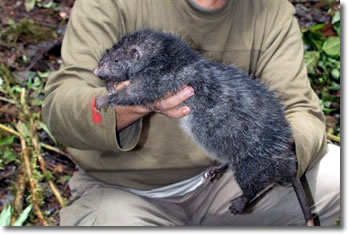BOSAVI WOOLLY RAT

For anyone afraid of rats, the story coming out of Papua, New Guinea in the spring of 2009 was truly the stuff of nightmares.
The gist of it? BBC scientists studying the crater of extinct volcano Mount Bosavi discovered more than 30 new species of animals—including a rat the size of a cat. Dubbed the Bosavi Woolly Rat, the creature weighed in at just over three pounds and was 32 inches long.
According to the team that found it, the rat was also quite friendly. The animals inside this crater were unafraid of humans, pretty much because they hadn't seen them very much," said
British zoologist George McGavin.
Besides the gentle giant of a rat, the discoveries included 16 new species of frogs, at least three new fish, and one bat. It was mind-blowing, McGavin told England's Guardian newspaper. The crater of Mount Bosavi really is the lost world.”
At the same time, scientists made the point that this sort of discovery is actually routine. In fact, writes Time magazine reporter Bryan Walsh,
biologists are identifying new species at a torrid rate, about 50 a day; nearly 17,000 new plants and animals were described in 2006 alone, or some 1% of the 1.8 million species that have been recognized so far.
How many species of plants and animals remain to be identified? There’s no way to know, of course, but estimates run from 5 million to 30 million to as many as 100 million.
“If the landscape reveals one certainty,” Annie Dillard writes in “Fecundity,” “it is that the extravagant gesture is the very stuff of creation.”
The extravagant gesture: the infinite generosity of a self-giving God.
Photo of Bosavi Woolly Rat courtesy of Bruce M. Beehler/AFP/Getty Images